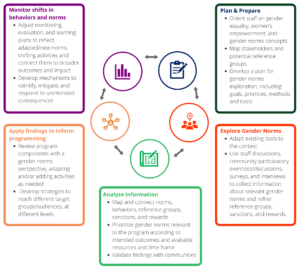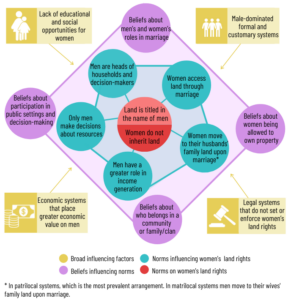How to Identify and Shift Harmful Gender Norms in the Context of Land and Natural Resources
Overview
USAID programs and Missions implement activities that improve land rights, support inclusive land and resource governance, build resilient livelihoods, and promote women’s empowerment. This brief explores the relationship between gender norms and women’s land rights, introducing key social norms concepts and tools to identify and shift harmful norms in the context of land and natural resources. The information will support USAID Missions, implementing partners, and other actors designing and implementing programs on land tenure and land-based investment to identify context-specific gender norms and design activities to shift harmful gender norms and strengthen women’s access to and control of land and resources.
What Are Social and Gender Norms?
When we walk into a store or clinic and need to wait for service, we most likely wait in a line. There may not be a sign telling us to wait in line, but we might see others in line and believe that others expect us to follow this social norm. Social norms are the unwritten or informal rules about what is typical or appropriate in a setting. They are embedded in communities, systems, and structures and can promote equitable or harmful behaviors and practices.
A type of social norm, gender norms are unwritten rules based on biological sex and/or social perceptions of gender. As gender is itself a social construct, gender norms describe which behaviors are appropriate and which are not appropriate according to one’s gender identity and include expectations of how people of different the gender identities should relate and interact. Through power dynamics and sanctions, harmful gender norms normalize and reinforce gender inequality and can limit women’s access to resources and their decision-making power. [1]
Attitudes, Behaviors, Beliefs, and Norms
Attitudes and behaviors are individual beliefs and actions that a person has or does, which may or may not be informed by social factors. Norms are collective beliefs about what is typical and appropriate behavior for certain people in a setting. Attitudes, norms, and behaviors do not always align. For example, a woman may have a personal belief that domestic partners or spouses should share household responsibilities, but the norm in her community might be that men should not engage in such tasks. She therefore may feel pressured to take on most of the household work and childcare.
Download the full brief here to view a table of key definitions.
Identifying, Exploring, and Monitoring Shifts in Gender Norms
Several tools have been developed to support program implementers to identify social and gender norms, design norms-shifting activities, and monitor shifts in norms.[2] As gender norms vary across communities and cultures, exploring these norms is usually best done before an activity or project begins. This way, findings can be used to better understand the context and to inform strategies that could help shift norms and develop appropriate indicators for monitoring and evaluation. Figure 1 describes steps of the process to identify gender norms, analyze information, apply findings to inform programming, and monitor shifts in norms. Since shifting gender norms takes time and action at different levels, this is an iterative and continuous process.

Gender Norms and Women’s Land Rights
Owning land is a powerful pathway to improving economic opportunity and livelihoods, fostering dignity and improved wellbeing, and building self-reliance in developing countries. Although women play a critical role in food production, they are less likely than men to own, inherit, and control land and natural resources, which limits their socioeconomic empowerment and increases their vulnerability to gender-based violence.[3] Inequality in the ownership, access, use, and control of land and natural resources is caused by multiple factors, including discriminatory legal and policy frameworks, male-dominated governance systems, unequal access to education and information, and harmful gender norms related to men’s and women’s public and private roles. These norms are maintained through attitudes, beliefs, behaviors, practices, and structures by those who hold power at multiple levels. Figure 2 shows how two gender norms affecting women’s land rights relate to broader gender norms, beliefs, and structural factors.

USAID Land and Resource Governance division (LRG) land projects such as Integrated Land and Resource Governance (ILRG) and Communications, Evidence and Learning (CEL) are using the concepts and frameworks described above to implement activities to shift harmful gender norms across countries at different levels and with different actors. A future brief will discuss the main gender norms related to land, natural resources, and agricultural value chains, as well as the gender norms-shifting approaches used, results, challenges, and lessons learned.
________________
[1] Parts of this brief were adapted from USAID’s Collective Action to Reduce Gender-Based Violence (CARE-GBV), How to Identify and Advance Equitable Social Norms, May 2021.
[2] USAID-funded Passages Project and the ALIGN (Advancing Learning and Innovation on Gender Norms) Platform have developed several resources and tools to explore, shift, and monitor gender norms. A list of resources is available at the end of this brief.
[3] Gender-based violence (GBV) is any harm or potential of harm perpetrated against a person or group on the basis of gender. It encompasses many expressions of violence – whether in public or private spaces – including physical, psychological, and sexual abuse; threats; coercion; and economic deprivation of land, property, and other resources.

